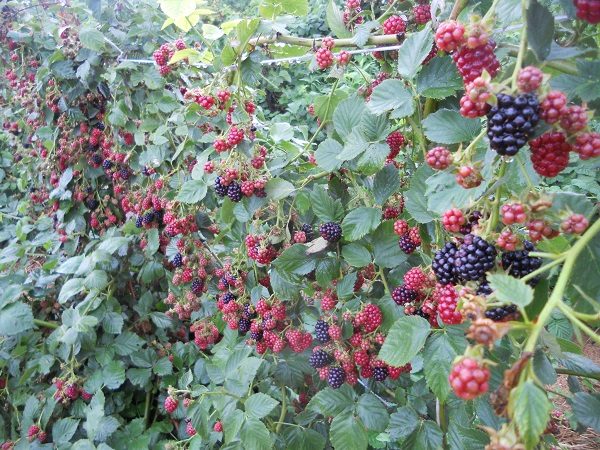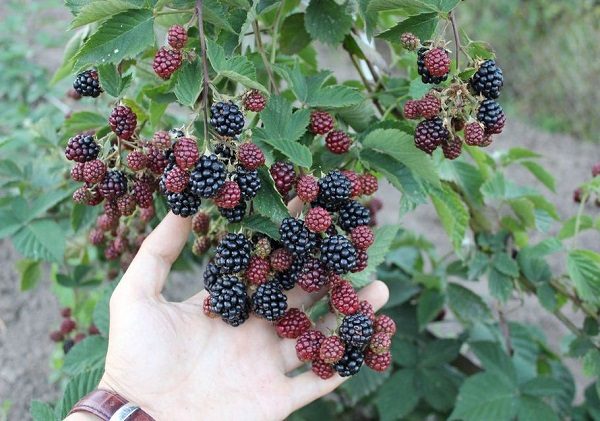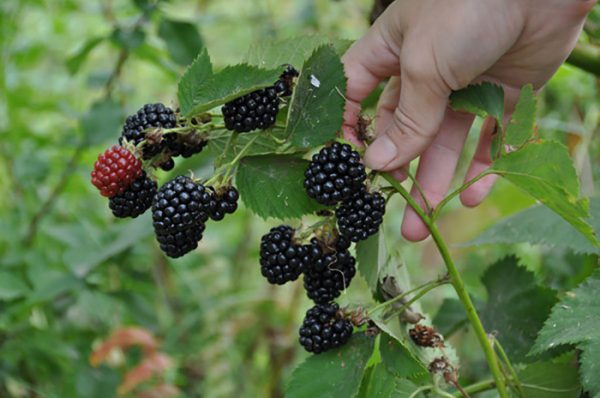The US state of Illinois, with its hot, humid summer, devastating tornadoes and winter snow storms, is the birthplace of many modern garden blackberry varieties.
It was there, at the University of Carbondale, by hybridizing the Darrow variety with Thornfrey and the US1482 breeding number that the superstar of Russian gardens was obtained - the blackberry Black Satin. Initially zoned for Illinois and California, it very quickly took over the landing areas throughout Europe and acclimatized in Russia.
Table of contents
Description of the variety
Let's start with the description of the variety of berries.Black Satin in its form occupies an intermediate position between the Cumaníks and the Rossians. This is a semi-nesting variety, the main characteristics of which are collected in the table:
| Habit | Strong bush, not prone to thickening. Root offspring does not form. |
| Shoots | The shoots are fast-growing, with a round cross-section, besshipye, very long - up to 5 meters. At the beginning of growth - upright. When growing over the mark of 1.5 meters begin to climb. Young vines of green color turn brown, as they mature. The second year is brown in color, very stiff and thick - up to 3 cm in diameter. The sheet is complex, serrate, of 3-5 sheet plates. |
| Bloom | Flowers blooming pink, on the next day fade to pale pink or white. |
| Fruiting | Exceptionally plentiful. The berries are large, up to 8 grams, black, with satin gloss, thanks to which the name of the variety appeared. The taste is excellent, sweet-sour, with a strong blackberry aroma. Maturation stretched from August to October. Some fruits catch the first snow. In fruiting comes the next year after planting. |
| Resilience | Cold resistance is moderate, up to -22⁰C. The tops of the shoots can freeze. Shelter is required for the winter.May be affected by gray mold. |
| Yield | Very high - up to 25 kg of berries from the bush per season. |
| Purpose of the fruit | Universal. |
| Transportability and curing | Both are low. Mature fruits are soft, quickly lose their presentation and deteriorate. |
Thus, Black Sateen blackberry has many advantages:
- large berries of excellent taste and versatile;
- high yield;
- shoot spinelessness;
- controlled bush density.
Of the minuses can be called:
- poor keeping quality and fruit transportability;
- insufficient frost resistance;
- instability to gray rot.

However, these shortcomings can be easily corrected. For example, gray rot affects overripe berries, and it is enough to remove them from the bush in time to avoid it. The extended fruiting allows to approach the plant every three days and take a small amount of fruits, immediately eating or releasing them for processing.
As for transportability, then according to some observations, this indicator increases significantly with the age of the plant. Berry from the old bush more dense structure,it is not so easy to choke and when deftly assembled, it is able to survive a brief relocation.
Planting and care
BlackBerry's place for planting BlackBerry is better to choose a sun, protected from drafts, with a light fertile soil. This variety does not tolerate stagnation of water, so drainage should be done on wet soils.
To place seedlings on a permanent place is better in the spring. However, if the planting material purchased in the fall, it does not matter: planting a plant in the fall, you need to take care of its shelter and care.
The blackness of the Black Satin variety is a double-edged sword. On the one hand, it allows you to shoot good harvests. On the other hand, it creates difficulties for sheltering an adult plant for the winter. The shoots of this blackberry bend very badly. There are two ways out.

"Raising" the correct position of the vine
Do not allow the plant to drive out upright shoots too far. Already when they reach the length of 35-40 cm, it is necessary to bend the branch to the ground and so fix. When the vine is 1.2 meters long, you can free it and put it on a trellis horizontally. For the winter, the escape with a bend is easily removed and placed under the shelter.
American cropping
At home, the BlackBerry Blackberry is formed into a compact bush according to this scheme:
- in the middle of summer, annual growths pinch the tops at a height of 110 cm, stimulating the growth of lateral shoots;
- in early spring, before the buds wake up, the lateral shoots are normalized: they grow below the 45-centimeter mark from the ground and the rest are shortened to a length of 40 cm;
- in autumn, the branches are cut off.
Delete spent "rags" need in any case. The blackberry vine, like the crimson vine, has a two-year development cycle, and after the second year it will only thicken the bush and promote the spread of gray rot.
To obtain annual good yields, the blackberry must be fed from the third year of life according to the scheme:
- Spring - nitrogen (5 kg of humus and 10 g of urea per 1 m2);
- autumn - potassium and phosphorus (100 g of superphosphate and 25 g of potash fertilizers).
Diseases and pests
Basically, this variety is resistant to damage by major blackberry diseases. The exception is gray rot, which has already been mentioned. Its pathogen, botrytis gray - a mold fungus, which is used in winemaking.
It can strike the plant already in the flowering phase. If it is cold rainy weather, whole inflorescences may suffer. In the later stages of the growing season, botrytis sits on the ovaries and fruits. Sick with gray rot, the berry looks as if rotten, covered with gray cannon. Therefore, it is better to take preventive measures in advance than to lose the harvest.
- The lower branches should not lie on the ground. In the wet ground are stored spores of botrytis.
- You can not allow the thickening of the bush. All vegetative parts of the plant must be ventilated.
- Remove ripe berries in a timely manner and remove rotted ones. Finding a sick escape, cut it out and burn it.
- In the spring, before flowering, spray the bush with Bordeaux mixture (3% solution).
Of the blackberry blackberry pests, blackberry mites are dangerous. This tiny insect can halve the harvest of berries. Unlike many other pests, the mite does not go to hibernate in the soil or under the bark. It settles right in the blackberry buds, and in the spring it migrates to inflorescences and berries. The fruits struck by this pest do not ripen, remaining reddish.
You can fight this scourge with Tiovit Jet, which is usually used to process grapes. Spray need to bloom before budding.

3 facts about blackberry black satin
- Researcher Fumiomi Takeda from the Appalachian Research Station conducted experiments with this variety. Blackberries were divided into groups, forming them with a different number of lashes: 3, 6, 9 and 12. The purpose of the experiment was to determine whether the number of shoots affects the yield of the plant. The result was curious: in terms of the total mass, Black Satin produced exactly the same result in all groups.The difference was in the size of the berries.
- Working with Blackberry Satin’s experienced Blackberry plantations, the same Fumiomi Takeda invented the rotary trellis. This device allows you to cover the plant for the winter without removing the lashes from the garter. It is enough just to translate it from the “summer” position to the “winter” one.
- It is believed that Black Satin is difficult to reproduce because it does not give root offspring. However, the practice of experienced gardeners shows that this variety is fairly easily rooted by the tips of the shoots. A good lower side shoot is chosen, pressed against the ground, fixed with a shackle, and buried. The procedure is carried out in the middle of summer. In the fall, you can separate the seedling from the mother plant and place it in a permanent place.
